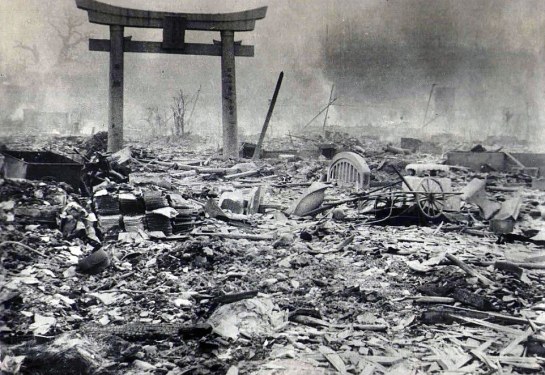And what better way to get back into things than with some light reading about crimes against humanity?
 The New York Times book critic Michiko Kakutani tweeted a link today to “Hiroshima”, a stunning, epic article, the first major journalistic investigation of the Hiroshima bombing, published 70 years ago this coming week, in The New Yorker. I ended up rereading large portions of the 30.000 word article, the horror coming back afresh.
The New York Times book critic Michiko Kakutani tweeted a link today to “Hiroshima”, a stunning, epic article, the first major journalistic investigation of the Hiroshima bombing, published 70 years ago this coming week, in The New Yorker. I ended up rereading large portions of the 30.000 word article, the horror coming back afresh.
The piece is just a completely devastating examination of the effects of the bomb. But really, through telling stories about the Hiroshima bombing, it is about how communities are destroyed, the fabric of life rent and torn by modern, industrialised warfare. The piece somehow seems to signal an expansion of consciousness about the horrors perpetrated by the allies in WWII, argues a very short recommendation of it in The Guardian today:
Subscribers to the 31 August 1946 edition of the New Yorker received their journal as usual, its cover adorned with a picnic. Inside, though, it was all change. Where the Talk of the Town column usually appeared, there begana 30,000-word article by a reporter, John Hersey. “To our readers,” said the note beneath it. “The New Yorker this week devotes its entire editorial space to an article on the almost complete obliteration of a city by one atomic bomb, and what happened to the people of that city. It does so in the conviction that few of us have yet comprehended the all but incredible destructive power of this weapon, and that everyone might well take time to consider the terrible implications of its use.” Later that year, this piece was published as a book,Hiroshima. It has never since been out of print.
The change lay in the way the piece told the stories of victims, according to The Guardian:
Lots of writers do this now, or try to, but then it was revolutionary; people hadn’t yet grasped that good reporting – the mind-changing kind – has as much to do with the quotidian and the intimately private as with “events”.
I’m not sure this is entirely true, stories about individual fates abound in witness literature through the ages, from Herodotus and Euripides on up until today. But there really is something new afoot in that piece by John Hersey, some acknowledment of the weight of lives destroyed by the Allieds. Some dawning through storytelling of the tragic nature of war itself. The dark heart of even the most just war. And there is something new in the scientific and detailed telling of the stories, too. A newness to the journalistic narrative.
If you can stand it, there are some terrible photos in the immediate aftermath of the bombing that shows the same horror of everyday humans smashed by unbelievable forces.
The UN is now working slowly towards a ban on nuclear weapons. Austria is leading the way on the slow legal campaign. But a counter-campaign led by Australia and the US is very hard to get around. There is a deep shame to this work for the preservation of nuclear weapons. A shame that the victims of Hiroshima in Hersey’s piece, or in Nagasaki, confront us with. And all of the potential madness, all of the unbelievable grief put away in storage in the Cold War, ready to fly at a moment’s notice is still there, still our responsibility.